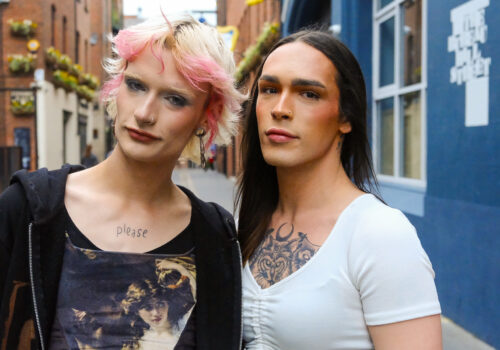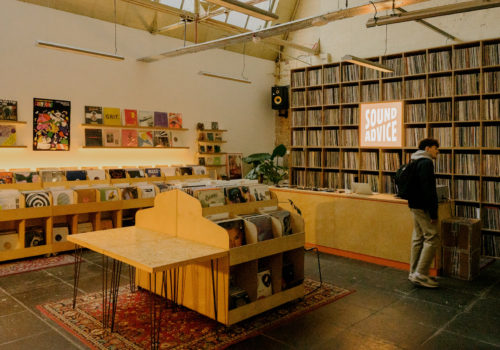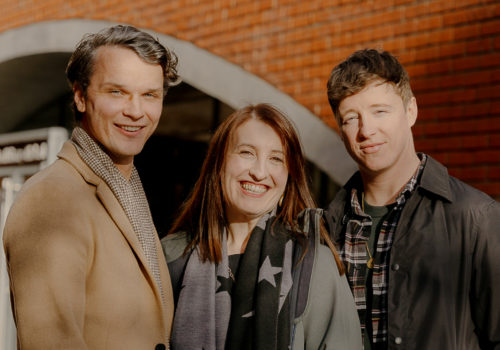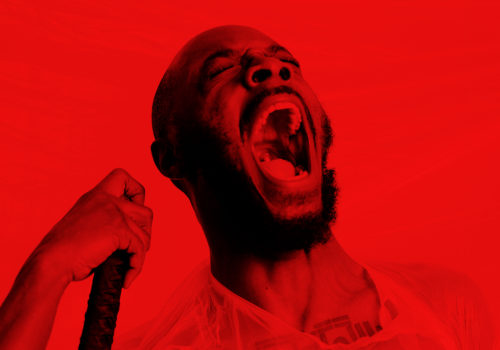Belfast’s Queer Community Is Reclaiming The City
Words: Esther Follis
Photography: Jack Farrar
The North has never had an accessible archive of queer lives or stories. Amidst decades of political instability and religious influence there has always been an attempt to hide these stories away in darkness and shadow: erased from public record, ignored by institutions, or softened into palatability. That’s how The Queer Photography Series started, born as a living archive documenting queer life in Belfast through photography, interviews, and personal testimony.
Jack Farrar, Esther Follis and Lucinda Graham presented this series at AVA Festival with support from Craic Magazine at the end of May. This is an archive that wants to live on, with plans to continue documenting queer life in Belfast through photography. This series is just the beginning.
Julia
At 3AM on a Belfast dance floor, surrounded by bodies moving to music that drowns everything else out, Julia Shields feels safest. As a 25-year-old trans woman, Julia knows the risks of walking home alone, of public transport, of the streets where she grew up in West Belfast. But here, in the sweat and noise and sacred chaos of queer nightlife, she’s untouchable.
“Queer joy is sweaty, silly, and sacred,” she tells me, describing those moments when being queer stops feeling like resistance and starts feeling like celebration.
Across Belfast, members of the LGBTQ+ community like Julia are refusing to be erased from spaces that have long tried to push queerness to the margins. “In those few hours in the club”, Julia tells me ,“I’m exactly who I want to be”.
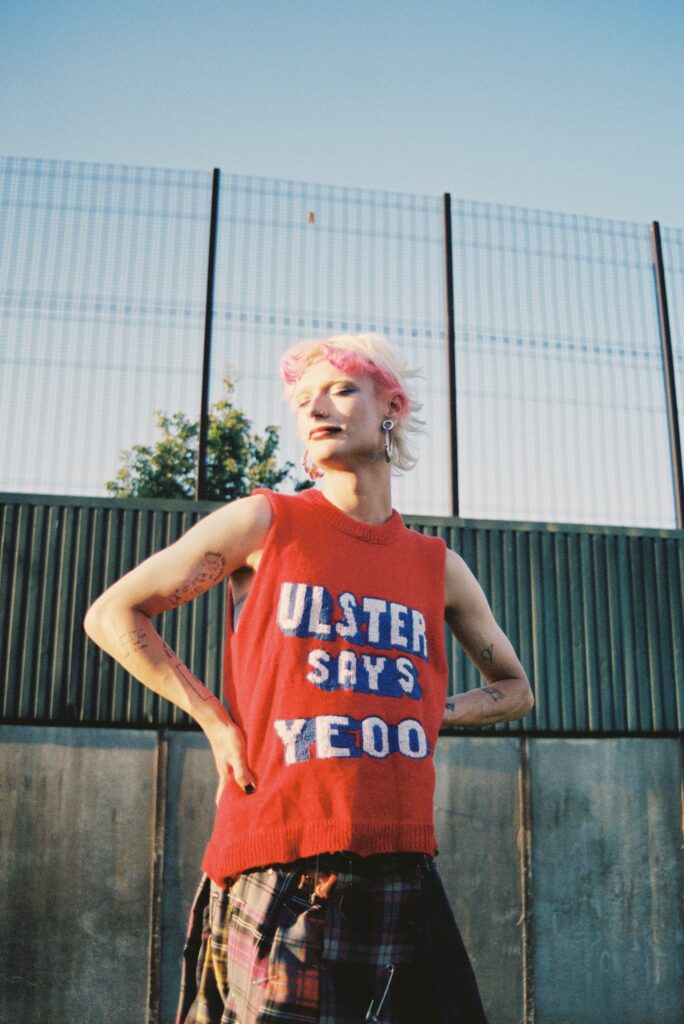

“Queer joy is sweaty, silly, and sacred” – Julia Shields
Marion

Photographer Jack Farrar has turned his lens to capture this defiance, “After chatting with the people I was photographing, the series took on its own life. The locations became very personal as well as connecting to those broader themes, often the very streets they grew up on,” Jack explains. This has grown into more than a series of photos, but a living, breathing archive.
As the light fades across the city, the pockets of queer joy Julia describes emerge in dark rooms with loud music – and one night in particular has stood the test of time. For over a decade, 47-year-old DJ and record-store owner Marion Hawkes, has been the co-founding force behind Ponyhawk, Belfast’s longest-running independent queer night. Ponyhawk has created spaces where people like Julia can feel that sacred safety. “We’re a country used to fighting,” Marion tells me. “Now we just have to keep fighting.” It’s fighting for acceptance, for safety, for integration and for the right to exist openly in these spaces.

Charles
Like Julia, 25 year-old Charles Roxas has found acceptance in these spaces, but Charles has started to reclaim space outside the nightlife realm, and inside his local church. “There’s a light inside queer people that others either want to amplify or extinguish. And maybe that’s our superpower.” For Charles, faith and identity have never been at odds.

He represents what’s possible when queer people aren’t just tolerated, but truly woven into the social fabric of Northern Ireland. As a queer, Asian man from West Belfast, Charles disrupts narrow ideas of what a Nationalist, or a Belfast man, should look like. “People don’t expect a queer, Asian man from West Belfast,” he says, “people don’t expect me to be what a Nationalist looks like.” For Charles, being from Belfast isn’t a contradiction to his queerness or heritage. It’s the foundation from which he reclaims all three.
His voice reminds us that queerness isn’t a monolith, and Belfast shouldn’t be either. Its strength lies in multiplicity, not uniformity.

“There’s a light inside queer people that others either want to amplify or extinguish. And maybe that’s our superpower.” – Charles Roxas
Medb

The perceived tension between queerness and religion has deep roots in Northern Ireland. In 1983, Belfast hosted the National Union of Students’ annual Lesbian and Gay Conference for the first time, just a year after homosexuality was finally decriminalised in the North. That decade-long delay was fuelled by Ian Paisley’s infamous “Save Ulster from Sodomy” campaign, which fused homophobia with religion and entrenched the idea that faith and queerness were incompatible. But even then, queer people were carving out space within that narrative, disrupting the silence and forcing the conversation into the public realm, yet these associations continue to cast shadows of shame over many lives today.
28-year-old Medb McPherson from Lisburn has experienced first-hand how religion can be used to marginalise queer identity. The phrase: “Please don’t tell me you’re a lesbian” was one that was repeated to Medb growing up by family members deeply devoted to Christianity and Unionism when she said she didn’t have a boyfriend.

Yet, as she grew older, she often spoke fondly to her family of a female best friend from decades past, how they lived together, how deeply they loved one another. Medb began to wonder if that repeated denial was rooted not in hatred, but in a shame she never learned to name.
“So many people think being queer and having faith are mutually exclusive,” Medb tells me. As our conversation goes on, we nod in agreement: use of religion to attack queer identity reflects fear, not faith. Medb’s portrait outside her local church in Lisburn isn’t about her personal belief – it’s a quiet but firm rebuke of the idea that queerness and spirituality are incompatible.
Those teenagers holding “Save Ulster from Sodomy” banners in 1983 understood something many still refuse to admit: love, of any kind, doesn’t threaten faith. Fear does.
“So many people think being queer and having faith are mutually exclusive,” – Medb

Lucinda
For 29 year-old Lucinda Graham, queer visibility is not just about being seen but about shedding all the burdens, not just religion, that have long shadowed queer existence in the North. Lucinda has been harassed on Belfast’s streets for presenting herself outside conventional feminine norms, for existing authentically in public space. “To live without the barrier of shame, that’s the barrier,” she says.” When you grow up being told your love is something to conceal or apologise for, unlearning that is a radical and difficult act.

That spirit of confrontation and creativity still defines how queer people navigate the North. Visibility remains both a victory and a risk. The portraits of The Queer Photography Project deliberately situate subjects within Belfast’s most symbolically charged spaces. These are locations shaped by contested histories and binary symbolism, where queer lives have been erased from collective memory or made incidental to broader narratives.
Each photograph becomes a quiet act of spatial reclamation. Rather than seeking to provoke, the project explores how queerness might inhabit these spaces differently, gently resign locations that carry rigid cultural meanings.

But Jack is clear about the boundaries of what such photography can achieve: “There are limits to what a photo series can do. Trans and queer safety and livelihoods aren’t just about representation – creative projects aren’t a substitute for material support and political organising.” But in Belfast’s context, he argues, visibility carries particular weight. “When our political culture is so visually mediated, I do think there’s something about documenting queer lives in that landscape, insisting they’ve always been there”.
Contrary to Ian Paisley’s claim that “homosexuality is the poison killing our Nation,” it is shame itself that has been and is the true poison. These portraits don’t just capture people; they mark territory, memory, and refusal. They remind us that queer lives have always been here, even when history tried not to see them. While visibility is not a solution in itself, in The North it is still an act of resistance, and a starting point for something deeper.

